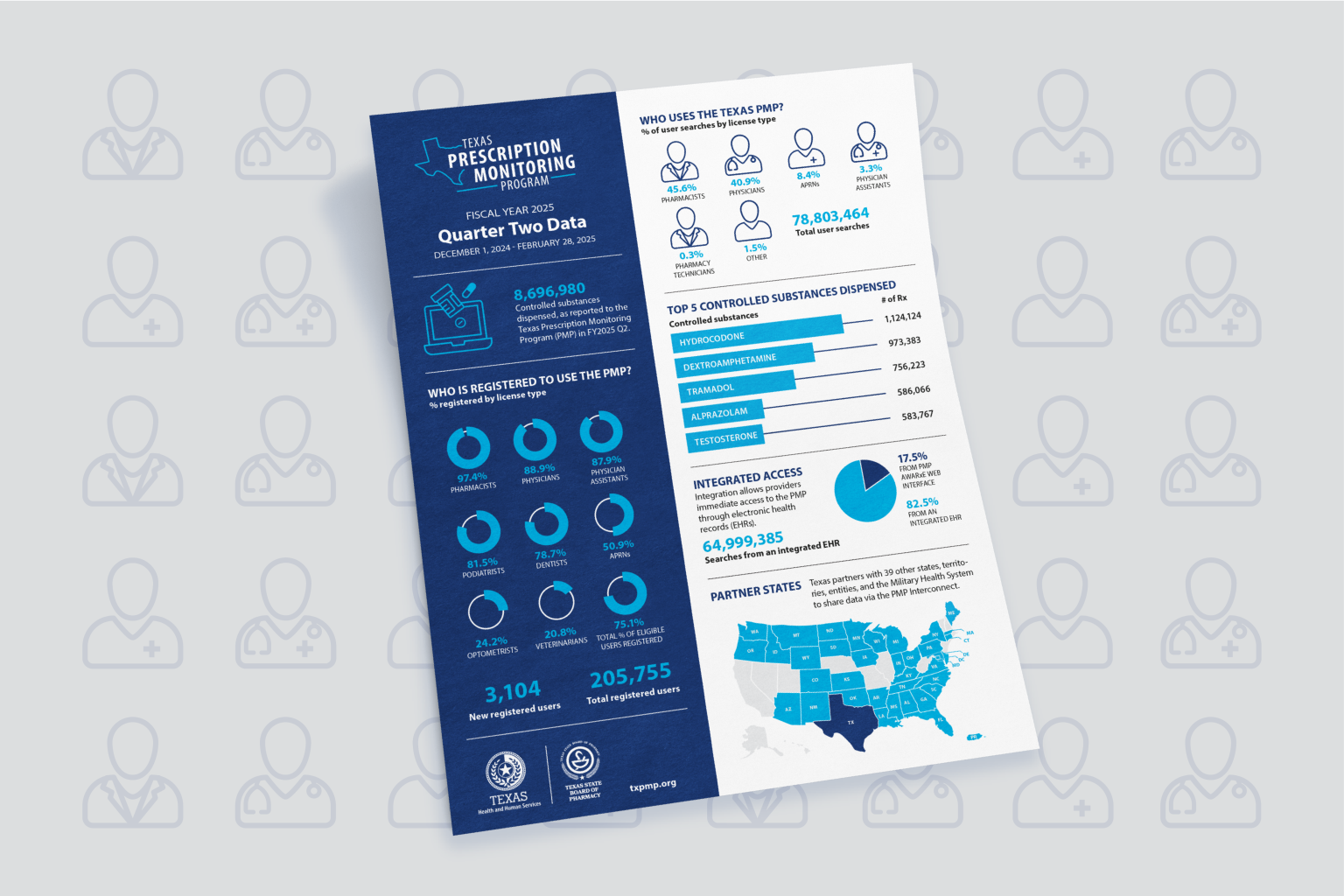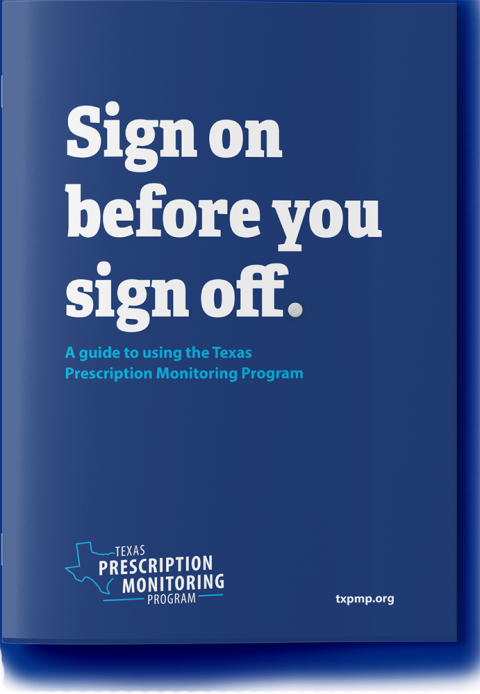Resources
Prescriber Toolkit
Prescribers, pharmacists, and other health care professionals often interact with patients who are experiencing pain. This toolkit is designed to assist you in having productive conversations with patients about the Texas PMP and the safe and effective alleviation of pain.
Guidelines & Talking Points
The Basics
Physicians, nurses, pharmacists, nurse practitioners, social workers, physical therapists and other healthcare professionals often interact with patients who are experiencing pain. The guidelines and talking points below are designed to help you make these conversations effective and satisfying for everyone.
Invite participation
Invite participation by explicitly encouraging patients to respond. Asking questions like, “How does that sound to you?” before or after providing information to patients can help establish a trusting relationship. In addition, this helps providers collect information from patients.
Use motivational interviewing techniques
such as asking open-ended questions and encouraging the patient to reflect on the positive effects of behavior change. This allows patients to explore their own circumstances, behaviors and treatment goals.
Use positive language
Use positive language like, “Sometimes we struggle to know exactly what causes this problem, but I can tell you that I will make my best effort to help you get comfortable” instead of, “I don’t know what’s wrong.” Avoid using negatives (e.g., “no” “not” “nothing” “never”).
Identify and treat psychosocial factors
that contribute to patient experiences of pain. Treating co-occurring psychological disorders may help alleviate a patient’s pain.
Affirm resilience
Affirm resilience by offering encouraging responses when patients disclose positive coping strategies. It’s important to identify, name, and celebrate positive coping strategies so that people can maintain hope and realize they can cope with pain and other stressors.
Summarize
the information that patients have shared, and then keep listening. Summarizing complex reflections and leaving space for patients to interject facilitates shared understanding.
Offer naloxone
and overdose prevention counseling if you are concerned about a patient’s substance use. Connect your patients to established local or state treatment and recovery services.
Still not sure if conversations about pain are going well?
Focus on making sure that the patient is the one doing most of the talking.
Practice listening while successfully resisting the urge to “fix it.”
Provide a safe, comfortable and private space. If possible, sit alongside the patient to foster a trusting dynamic.
"[Patient name], let’s talk more about how to get you comfortable. I’d like to know more about how you’ve managed pain in the past."
Use affirmative language that fosters mutual trust. Avoid asking “Why don’t you...”
“We want to make sure it’s safe for you.”
“What about if we...”
Demonstrate empathetic, active listening by using reflective statements and a nonjudgmental approach. Avoid seeming rushed, and pause when necessary.
“What I hear you saying is [paraphrase]. Is that right?” “I understand your concerns.” “Does that fit with what you were thinking?”
Avoid stigmatizing language (e.g., “addict”).
Use patient-centered language that focuses on behaviors (“misusing medication”) instead of identities (“a user”). Avoid labels.
Before ending the conversation, use the teach-back method to ensure patient understanding. Ask patients to repeat back your mutually agreed upon plan using their own words. Clarify or add information when necessary.
“Can you repeat back to me what our plan is?”
“Yes, and I want to remind you...”
Ask patients what questions they have. Make sure they know how to get in touch if they have questions later on.
“What questions do you have?”
“Here is how you can reach us...”
Start with open-ended questions. Ask about patients’ experiences with pain and how they have managed pain in the past. Maintain eye contact and use visual cues to help you gather patient information.
Has there been a time in your life when you had to manage pain? What worked or didn’t work before?
Use affirmative language that fosters mutual trust. Avoid asking “Why don’t you...”
“Those are great strategies for managing pain.”
“Let’s talk about other ways to get you comfortable. Have you tried [physical therapy]?”
Consider screening patients for depression, anxiety and risk of opioid use disorder. Most pain has both physiological and psychosocial elements.
“Research shows a strong connection between emotional well-being and our experience of pain. Consulting with a mental health professional is one of many options that we can explore together to manage your pain.”
If patients become upset or angry, ask about their concerns, worries, or fears. Follow up with the patient’s response. Emphasize common goals like patient comfort. Acknowledge emotions and ask open-ended questions.
“What are your concerns [about using acetaminophen]? Tell me more about that.”
“I hear you. I understand this may be [unexpected/not what you want to discuss today]. Let’s figure this out together.”
Explain what it is, and why you are using it.
“It is our policy to check the PMP for every patient, every time.”
Summarize the PMP results to the patient and confirm the accuracy of the data.
“I see that [summarize the Texas PMP results]. Is that correct?”
If you have concerns about PMP results, state the facts and ask non-judgemental questions to gain more information.
“I noticed that you have been getting [drug name] from [prescriber name]. Can you tell me more about that?”
Clarify or restate clinic policies to shift the conversation to safe and effective alleviation of pain.
“At our office, patients can only receive opioids from one prescriber. It looks like for you, that’s Dr. [prescriber name]. Is that right?”
“Since I cannot prescribe you opioids, can we talk about other ways we can work together to alleviate your pain?”
Before ending the conversation, use the teach-back method to ensure patient understanding. Ask patients to repeat back your mutually agreed upon plan using their own words. Clarify or add information when necessary.
“Can you repeat back to me what our plan is?" "Yes, and I want to remind you...”
Ask patients what questions they have. Make sure they know how to get in touch if they have questions later on.
“What questions do you have?" "We will call you tomorrow morning. Here is how you can reach us..."
Get the Toolkit
Getting to Know Patient Rx History
The PMP allows prescribers and pharmacists to gain in-depth insight into patient prescription histories and to initiate productive conversations about safe and effective alleviation of pain.
Policy Template
Create a customized policy
Having a policy to refer to when talking with patients can help depersonalize discussions about safe and effective alleviation of pain.
At [ Name of clinic or hospital ] we value your safety and comfort. Before prescribing certain medications, we always check the Texas Prescription Monitoring Program (PMP), a statewide database that tracks prescription data of controlled substances and medications with misuse potential. These medications include opioids, benzodiazepines, barbiturates, stimulants, sedatives, and muscle relaxers.
| Prescription Type | Common Drug Example |
|---|---|
| Benzodiazepines | Alprazolam (e.g., Xanax), clonazepam (e.g., Klonopin), diazepam (e.g., Valium) |
| Barbiturates | Amobarbital (e.g., Amytal), secobarbital (e.g., Seconal) |
| Stimulants | Amphetamine (e.g., Adderall), methylphenidate (e.g., Ritalin), phentermine |
| Sedatives | Zolpidem (e.g., Ambien), Zaleplon (e.g., Sonata), Eszopiclone (e.g., Lunesta) |
| Muscle Relaxers | Carisoprodal (e.g., Soma) |
Your safety, comfort, and wellbeing are our priority. Your safety comes before all else.
[ Name of clinic or hospital ]
[ Address ]
[ Phone Number ]
PMP Data
What We Know
The data sheets below provide detailed information on controlled substance prescriptions dispensed in Texas, PMP usage statistics, state data sharing partnerships, and other critical data. These sheets are updated regularly, check back for quarterly reports.

View Previous Data
For more information from the Texas PMP, visit the DSHS Center for Health Statistics.
